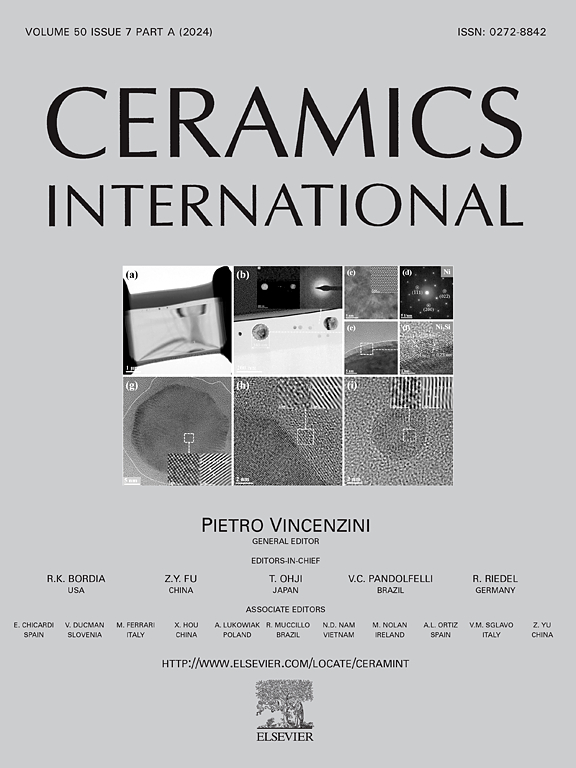通过提高晶粒生长活化能来改善氮化硼纳米片/CuTi复合材料的高温力学性能
IF 5.1
2区 材料科学
Q1 MATERIALS SCIENCE, CERAMICS
引用次数: 0
摘要
为了开发新一代高强、耐热的Cu材料,采用基体合金化和粉末冶金技术制备了氮化硼纳米片/CuTi复合材料。通过BNNS与Ti之间的固相界面反应,构建界面三维结构(I-3DS),将机械键合的二维界面转变为化学键合的三维界面,显著提高了界面的键合强度。BNNS/CuTi复合材料表现出优异的力学性能,在573 K时抗拉强度达到480±6 MPa,在现有耐热Cu材料中具有较强的竞争力。实验和模拟结果表明,BNNS提高了复合材料晶粒生长活化能,有效抑制了高温变形过程中晶界迁移和晶粒旋转,从而提高了复合材料的高温稳定性。BNNS和I-3DS创造性地突破了制约Cu基复合材料(cmc)高温力学性能提高的瓶颈,为新一代耐热cmc的开发和应用打开了一扇窗。本文章由计算机程序翻译,如有差异,请以英文原文为准。
Improving the high temperature mechanical properties of boron nitride nanosheet/CuTi composite by increasing grain growth activation energy
In order to develop a new generation of high-strength, heat-resistant Cu material, boron nitride nanosheet (BNNS)/CuTi composite was fabricated using matrix alloying and powder metallurgy techniques. The interfacial three-dimensional structure (I-3DS) was constructed by solid-state interfacial reactions between BNNS and Ti, and the mechanically bonded 2D interface was transformed into a chemically bonded 3D interface, which significantly improved interface bonding strength. BNNS/CuTi composite exhibited outstanding mechanical properties, with an ultimate tensile strength of 480 ± 6 MPa at 573 K, which has high competitiveness among existing heat-resistant Cu materials. Experimental and simulation results showed that BNNS increased composite grain growth activation energy, effectively inhibit grain boundary migration and grain rotation during high temperature deformation, so as to improve high temperature stability. BNNS and I-3DS creatively break through the bottleneck restricting improvement of high temperature mechanical properties in Cu matrix composites (CMCs), and opens a window for development and application of a new generation of heat-resistant CMCs.
求助全文
通过发布文献求助,成功后即可免费获取论文全文。
去求助
来源期刊

Ceramics International
工程技术-材料科学:硅酸盐
CiteScore
9.40
自引率
15.40%
发文量
4558
审稿时长
25 days
期刊介绍:
Ceramics International covers the science of advanced ceramic materials. The journal encourages contributions that demonstrate how an understanding of the basic chemical and physical phenomena may direct materials design and stimulate ideas for new or improved processing techniques, in order to obtain materials with desired structural features and properties.
Ceramics International covers oxide and non-oxide ceramics, functional glasses, glass ceramics, amorphous inorganic non-metallic materials (and their combinations with metal and organic materials), in the form of particulates, dense or porous bodies, thin/thick films and laminated, graded and composite structures. Process related topics such as ceramic-ceramic joints or joining ceramics with dissimilar materials, as well as surface finishing and conditioning are also covered. Besides traditional processing techniques, manufacturing routes of interest include innovative procedures benefiting from externally applied stresses, electromagnetic fields and energetic beams, as well as top-down and self-assembly nanotechnology approaches. In addition, the journal welcomes submissions on bio-inspired and bio-enabled materials designs, experimentally validated multi scale modelling and simulation for materials design, and the use of the most advanced chemical and physical characterization techniques of structure, properties and behaviour.
Technologically relevant low-dimensional systems are a particular focus of Ceramics International. These include 0, 1 and 2-D nanomaterials (also covering CNTs, graphene and related materials, and diamond-like carbons), their nanocomposites, as well as nano-hybrids and hierarchical multifunctional nanostructures that might integrate molecular, biological and electronic components.
 求助内容:
求助内容: 应助结果提醒方式:
应助结果提醒方式:


